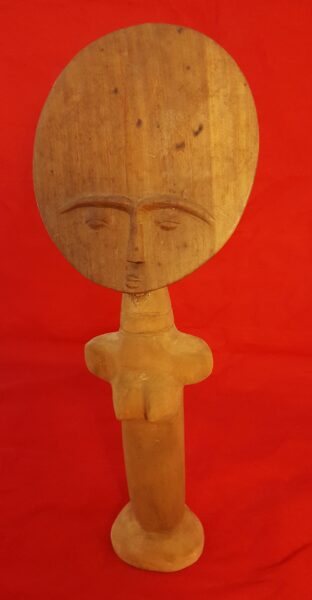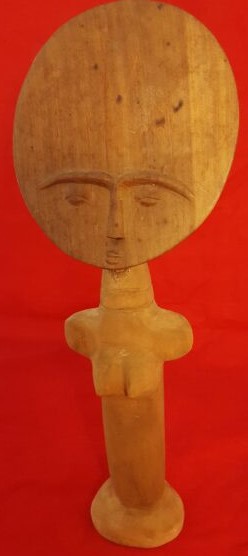The Akua’ba (plural Akua’ma) is a famous type of sculpture made by the Asante cultures of the country of Ghana, in Western Coastal Africa. These figures are made in a very recognizable form, typically with a flattened round or oval head with a high forehead; heavy, curved eyebrows; almond-shaped, downcast eyes; a straight, pyramid-shaped nose; and a tiny mouth. They also have stick-like bodies, ringed necks, short arms, prominent cone-shaped breasts, and sometimes a protruding navel. All of these features together represent the traditional standards of beauty for young adult Asante women; hands, legs, and feet are not portrayed because they assume no important roles in these standards. The akua’ba in this exhibit is unusual in being left the original light brown color of the wood, as akua’ma are also often stained a dark color because shiny, dark skin is also considered to be beautiful.
The main purpose of an akua’ba is to help women who are having difficulty becoming pregnant. The figure is virtually always female because the Asante are matrilineal, and the akua’ba is portrayed as a young adult because the aspiring mother hopes for a child that will survive to adulthood and carry on the family line. The woman will commission a woodcarver to make a figure with the typical features; after the figure is carved to her specifications, the woman then takes the figure to a local indigenous priest to have the figure blessed, and then she carries the akua’ba figure with her and cares for it as she would a real child, in the hopes that she will receive divine help in conceiving.
Once the woman successfully gives birth to a child, she may deposit the akua’ba figure in a shrine to thank the god who assisted in her pregnancy, or she may give the akua’ba to her daughter so that she can learn child care and will have the figure to use in the future, if necessary. If a woman’s child dies, sometimes she will keep the figure as a tribute to the child; some women even choose to have the akua’ba figure buried alongside her when she passes away.

Asante culture
20th century
Wood, L. 12.3 cm x W. 1.6 cm x H. 13.8 cm (unrestored)
BFPC collection #2014.47
For more information, you may contact the researcher(s) noted in the title of this exhibit entry, or Dr. Billie Follensbee, the professor of the course, at BillieFollensbee@MissouriState.edu

